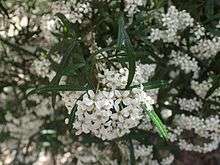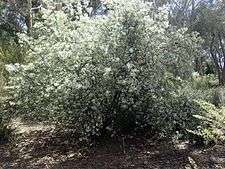Zieria arborescens
Zieria arborescens, commonly known as the tree zieria or stinkwood, is a plant in the citrus family Rutaceae and is endemic to eastern Australia. It is a bushy shrub or small tree with branches that are ridged and scaly or hairy, at least when young. It has leaves composed of three leaflets and groups of flowers with four white petals, the groups usually shorter than the leaves.
| Zieria arborescens | |
|---|---|
 | |
| Zieria arborescens leaves and flowers | |
| Scientific classification | |
| Kingdom: | Plantae |
| Clade: | Tracheophytes |
| Clade: | Angiosperms |
| Clade: | Eudicots |
| Clade: | Rosids |
| Order: | Sapindales |
| Family: | Rutaceae |
| Genus: | Zieria |
| Species: | Z. arborescens |
| Binomial name | |
| Zieria arborescens | |
Description
Zieria arborescens is a robust shrub or small tree which grows to a height of 5–10 m (20–30 ft). Its branches are ridged where older leaves have fallen and are usually scaly or hairy, at least when young. The leaves are composed of three leaflets which vary in size and shape but are mostly lance-shaped or oblong, 50–90 mm (2–4 in) long and 6–15 mm (0.2–0.6 in) wide with a stalk 15–30 mm (0.6–1 in) long. The edges of the leaves are more or less rolled downwards with the upper surface dark green and glabrous while the lower surface is hairy and pale in colour. Both surfaces of the leaf are dotted with oil glands.[1][2][3]
The flowers are white or pale pink and are arranged in large groups in upper leaf axils, the groups usually shorter than the leaves. There are four more or less hairy, triangular sepal lobes about 1.5–2.5 mm (0.06–0.1 in) long. The four petals are 3–6.5 mm (0.1–0.3 in) long and slightly hairy. In common with other zierias, there are only four stamens. Flowering occurs from September to November and is followed by a capsule containing seeds which have an ant-attracting elaiosome.[1][2][3][4]

Taxonomy and naming
Zieria arborescens was first formally described in 1811 by English taxonomist John Sims and the description was published in Botanical Magazine. The original specimen was from Joseph Banks's collection in London.[5][6] The specific epithet (arborescens) is derived from the Latin word arbor meaning "tree"[7]:813 with the suffix -escens meaning "about to become" or "almost".[7]:44
Three subspecies have been described and others remain in the manuscript stage:
Distribution and habitat
This zieria occurs in Queensland, New South Wales, Victoria and Tasmania, growing in wet forest and at the margins of rainforest. Subspecies glabrifolia only occurs on the New England Tablelands between the Girraween National Park in Queensland and Torrington in New South Wales. Subsp. decurrens is only recorded from near Jervis Bay where it grows in drier eucalyptus areas and features ridged non-warty branches and more hairs on the young branchlets.[2]
 Zieria arborescens in the Watagans National Park
Zieria arborescens in the Watagans National Park
References
- Armstrong, James Andrew; Harden, Gwen. "Zieria arborescens". Royal Botanic Garden Sydney; plantnet. Retrieved 22 October 2016.
- Armstrong, James Andrew (2002). "A taxonomic revision of the genus Zieria Sm. (Rutaceae) in Queensland". Austrobaileya. 15 (3): 485–486.
- Fairley, Alan; Moore, Philip (2010). Native plants of the Sydney region : from Newcastle to Nowra and west to the Dividing Range (3rd ed.). Crows Nest, N.S.W.: Allen & Unwin. p. 338. ISBN 9781741755718.
- "Zieria arborescens". Understorey Network. Retrieved 22 October 2016.
- "Zieria arborescens". APNI. Retrieved 22 October 2016.
- Sims, John (1811). "Zieria smithii Lanceolate zieria". Curtis's Botanical Magazine. 34: 1395. Retrieved 22 October 2016.
- Brown, Roland Wilbur (1956). The Composition of Scientific Words. Washington, D.C.: Smithsonian Institution Press.
- "Zieria arborescens subsp. arborescens". APNI. Retrieved 22 October 2016.
- "Zieria arborescens subsp. decurrens". APNI. Retrieved 22 October 2016.
- "Zieria arborescens subsp. glabrifolia". APNI. Retrieved 22 October 2016.
External links
